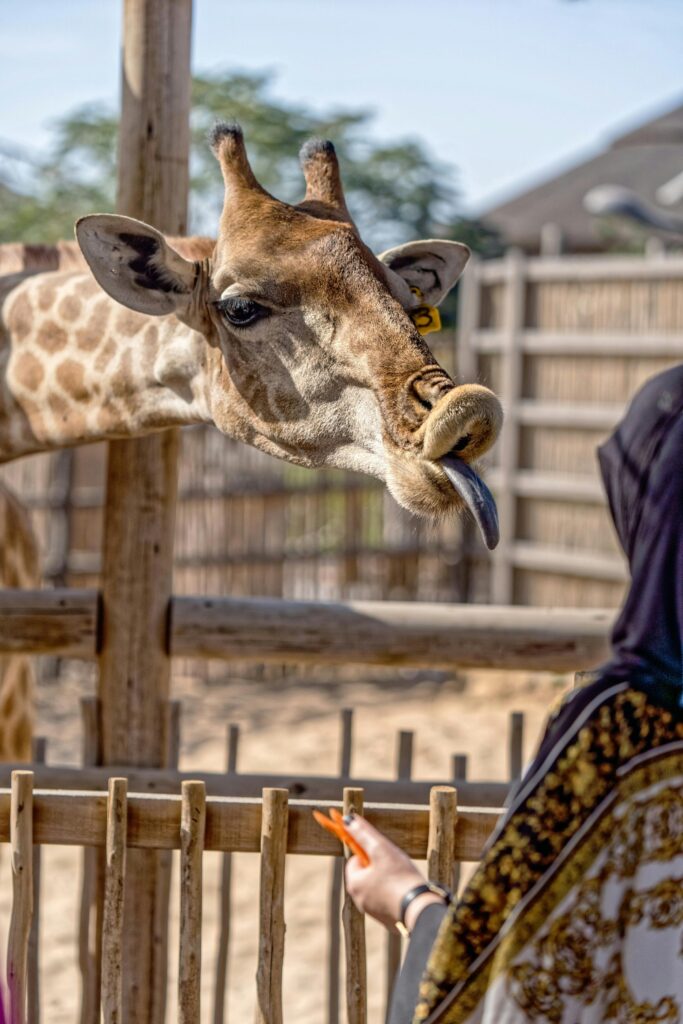
Source:https://www.pexels.com/
When we think of giraffes, the first thing that comes to mind is their long necks. These gentle giants stand tall among all land animals, reaching heights of up to 18 feet. But there is another part of a giraffe that deserves just as much attention—its tongue. The giraffe tongue is a fascinating feature, and it plays an important role in the animal’s survival. Let’s take a closer look at this amazing part of nature.
What Does a Giraffe Tongue Look Like?

Source:https://www.pexels.com/
The tongue of a giraffe is not like the tongue of a human or most other animals. First, it is extremely long. A giraffe’s tongue can measure between 18 and 20 inches (45 to 50 centimeters) in length. This allows the giraffe to reach leaves that are high up in trees or hidden deep within branches.
Another unique feature of the giraffe tongue is its color. It is usually dark purple, black, or bluish in color. Scientists believe this dark coloration helps protect the tongue from sunburn. Since giraffes spend many hours each day eating from tall trees under the hot sun, this adaptation is very useful.
How Does a Giraffe Use Its Tongue?

Giraffes mainly use their tongues to feed. They eat leaves, flowers, and fruits, especially from acacia trees. Acacia trees are covered in sharp thorns, but this does not stop giraffes. Their tongues are tough and have thick layers, which protect them from getting injured by the thorns.
In addition, the giraffe tongue is very flexible and prehensile. “Prehensile” means it can grab or hold onto things, much like the way a monkey’s tail works. This allows the giraffe to wrap its tongue around branches, pull off leaves, and eat them with ease. The tongue works like a special tool, helping the giraffe gather food quickly and efficiently.
Why Is the Giraffe Tongue So Important?

Source:https://www.pexels.com/
The giraffe tongue is essential for the animal’s survival. Giraffes live in parts of Africa where food and water can be hard to find, especially during dry seasons. Their ability to reach high branches and eat leaves that other animals cannot access gives them a big advantage.
Giraffes also eat a lot of food every day to stay healthy and strong. An adult giraffe can eat up to 75 pounds (34 kilograms) of leaves daily. Without their long and tough tongues, they would not be able to gather enough food to meet their needs.
Fun Facts About the Giraffe Tongue

Source:https://www.pexels.com/
Here are some interesting facts about giraffe tongues:
- Saliva as Protection: Giraffe saliva is thick and sticky. This helps protect their mouths and tongues from sharp thorns. The saliva also helps to start breaking down food before it reaches the stomach.
- Tongue Dexterity: Giraffe tongues are so flexible that they can even clean their ears! This might seem strange, but it shows just how skilled their tongues are.
- Tongue Strength: A giraffe’s tongue is very strong. It can grab and pull down branches with surprising force.
- Unique Patterns: Just like humans have fingerprints, every giraffe’s tongue has a unique texture and pattern.
- Helping Hand: Giraffes sometimes use their tongues to remove bugs from their faces or bodies. This keeps them clean and comfortable.
The Science Behind the Giraffe Tongue

Source:https://www.pexels.com/
The giraffe tongue is a perfect example of how animals adapt to their environments. Scientists call this process “evolution.” Over many thousands of years, giraffes developed long tongues to help them survive in their natural habitat. Without this adaptation, giraffes might not be able to compete for food and thrive as they do today.
The dark color of the tongue, its tough surface, and its ability to stretch and grab are all results of this evolutionary process. Together, these features make the giraffe tongue one of the most specialized tools in the animal kingdom.
How Do Giraffe Tongues Compare to Other Animals?

Source:https://www.pexels.com/
While the giraffe tongue is unique, it is not the only example of an animal with a special tongue. For example, anteaters have long tongues that they use to catch ants and termites. Chameleons also have tongues that can stretch far out of their mouths to catch insects. However, the giraffe tongue stands out because of its size, strength, and versatility.
Another interesting comparison is the human tongue. The average human tongue is only about 3 inches (7.6 centimeters) long. While our tongues are important for speaking and eating, they are not nearly as specialized as a giraffe’s tongue.
Protecting Giraffes and Their Amazing Tongues

Source:https://www.pexels.com/
Unfortunately, giraffes face many threats in the wild. Habitat loss, poaching, and climate change are all challenges that put giraffe populations at risk. Conservation efforts are important to protect these magnificent animals and their unique features, like their tongues.
Organizations around the world are working to create safe habitats for giraffes, prevent illegal hunting, and raise awareness about the importance of these animals. By supporting these efforts, we can help ensure that future generations get to admire giraffes and learn about their fascinating tongues.

Source:https://www.pexels.com/
Why Should We Care About Giraffe Tongues?
The giraffe tongue is more than just an interesting fact. It is a symbol of how animals adapt to their environments and overcome challenges. By learning about the giraffe tongue, we can gain a greater appreciation for nature and the amazing ways it works.
Moreover, studying giraffes and their tongues can teach us valuable lessons about biology, evolution, and conservation. The more we understand about these animals, the better equipped we are to protect them and their habitats.

Source:https://www.pexels.com/
The giraffe tongue is truly one of nature’s incredible wonders. Its length, strength, and flexibility make it a vital tool for feeding and survival. From its dark color to its prehensile abilities, every feature of the giraffe tongue has a purpose.
As we continue to learn about giraffes and their unique traits, let us remember to value and protect the natural world. By doing so, we can ensure that these gentle giants and their amazing tongues remain a part of our planet for years to come.













